Selective release of ATP from sympathetic nerves of rat vas deferens by the toxin TsTX-I from Brazilian scorpion Tityus serrulatus
- PMID: 15678093
- PMCID: PMC1576030
- DOI: 10.1038/sj.bjp.0706062
Selective release of ATP from sympathetic nerves of rat vas deferens by the toxin TsTX-I from Brazilian scorpion Tityus serrulatus
Abstract
1. The effects of the main component of the Tityus serrulatus scorpion venom, toxin TsTX-I, were studied on the contractility and release of neurotransmitters in the rat vas deferens. Since TsTX-I is known to act on sodium channels, we used veratridine, another sodium channel agent, for comparison. 2. Toxin TsTX-I induced concentration-dependent contractions with an EC(50) value of 47.8+/-0.1 nM and a maximum effect of 84.4+/-10.4% of that for BaCl(2). 3. Contractions by TsTX-I were abolished by denervation or tetrodotoxin (0.1 microM), showing that the toxin effects depend on the integrity of sympathetic nerve terminals. 4. To check for the presence of a noradrenergic component, experiments were conducted after removal of adrenergic stores in nerve terminals by reserpinization (10 mg kg(-1), 24 h prior to experiments) or blockade of alpha(1) adrenoceptors by prazosin (30 microM), showing that these procedures did not modify the response to TsTX-I, and therefore that adrenoceptors were not involved in contractions. 5. To check for the presence of a purinergic component, experiments were carried out after blockade of P(2X) receptors by suramin (0.1 mM) or desensitization by alpha,beta-methylene-ATP (30 microM). These agents greatly abolished the contractile response to TsTX-I (about 83% by desensitization and 96% by suramin), showing the involvement of purinergic receptors. 6. The release of noradrenaline and purinergic agents (ATP, ADP, AMP and adenosine) was detected by HPLC. Together, the total release of purines in the presence of TsTX-I was about 42 times higher than in the control group. In contrast, TsTX-I did not modify the overflow of noradrenaline, showing that the release was selective for purines. 7. The release of purinergic agents was reduced by the N-type calcium channel blocker omega-conotoxin GVIA (1 microM) and by the P/Q-type blocker omega-conotoxin MVIIC (1 microM), showing that the effects of TsTX-I are calcium-dependent. 8. The results show that TsTX-I produced a selective release of purines from postganglionic sympathetic nerves in the rat vas deferens.
Figures
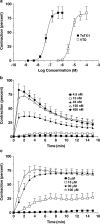
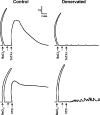
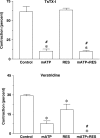
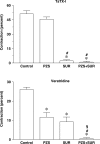
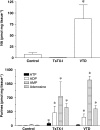
Similar articles
-
Role of N-, P- and Q-type voltage-gated calcium channels in transmitter release from sympathetic neurones in the mouse isolated vas deferens.Br J Pharmacol. 1997 Feb;120(3):393-8. doi: 10.1038/sj.bjp.0700948. Br J Pharmacol. 1997. PMID: 9031741 Free PMC article.
-
Effects induced by Tityus serrulatus scorpion venom and its toxins TsTX-I and TsTX-V on the rat isolated retractor penis muscle.Pharmacology. 2005 Mar;73(4):190-8. doi: 10.1159/000082804. Epub 2004 Dec 17. Pharmacology. 2005. PMID: 15608440
-
Omega-conotoxin GVIA-resistant neurotransmitter release from postganglionic sympathetic nerves in the guinea-pig vas deferens and its modulation by presynaptic receptors.Br J Pharmacol. 1998 Jan;123(2):167-72. doi: 10.1038/sj.bjp.0701577. Br J Pharmacol. 1998. PMID: 9489603 Free PMC article.
-
ATP as a co-transmitter with noradrenaline in sympathetic nerves--function and fate.Ciba Found Symp. 1996;198:223-35; discussion 235-8. doi: 10.1002/9780470514900.ch13. Ciba Found Symp. 1996. PMID: 8879828 Review.
-
Autoinhibition, sympathetic cotransmission and biphasic contractile responses to trains of nerve stimulation in the rodent vas deferens.Clin Exp Pharmacol Physiol. 1998 Dec;25(12):965-73. doi: 10.1111/j.1440-1681.1998.tb02169.x. Clin Exp Pharmacol Physiol. 1998. PMID: 9887992 Review.
Cited by
-
Neurotoxicity of Tityus bahiensis (brown scorpion) venom in sympathetic vas deferens preparations and neuronal cells.Arch Toxicol. 2020 Sep;94(9):3315-3327. doi: 10.1007/s00204-020-02799-y. Epub 2020 Jun 16. Arch Toxicol. 2020. PMID: 32548756 Free PMC article.
-
Physiological and biochemical analysis of L. tredecimguttatus venom collected by electrical stimulation.J Physiol Biochem. 2007 Sep;63(3):221-30. doi: 10.1007/BF03165785. J Physiol Biochem. 2007. PMID: 18309778
-
First evidence of Tityus confluens Borelli, 1899 (Buthidae) venom altering purine metabolism in rat blood cells.Purinergic Signal. 2025 Feb 24. doi: 10.1007/s11302-025-10076-9. Online ahead of print. Purinergic Signal. 2025. PMID: 39992594
-
Antioxidant treatment restores prejunctional regulation of purinergic transmission in mesenteric arteries of deoxycorticosterone acetate-salt hypertensive rats.Neuroscience. 2010 Jun 30;168(2):335-45. doi: 10.1016/j.neuroscience.2010.03.061. Epub 2010 Apr 14. Neuroscience. 2010. PMID: 20398741 Free PMC article.
References
-
- ARISPE N., JAIMOVICH E., LIBERONA J.L., ROJAS E. Use of selective toxins to separate surface and tubular sodium currents in frog skeletal muscle fibers. Pflugers Arch. 1988;411:1–7. - PubMed
-
- BARHANIN J., GIGLIO J.R., LEOPOLD P., SCHMID A., SAMPAIO S.V., LAZDUNSKI M. Tityus serrulatus venom contains two classes of toxins. Tityus gamma toxin is a new tool with a very high affinity for studying the Na+ channel. J. Biol. Chem. 1982;257:12553–12558. - PubMed
-
- BARHANIN J., ILDEFONSE M., ROUGIER O., SAMPAIO S.V., GIGLIO J.R., LAZDUNSKI M. Tityus gamma toxin, a high affinity effector of the Na+ channel in muscle, with a selectivity for channels in the surface membrane. Pflugers Arch. 1984;400:22–27. - PubMed
-
- BARHANIN J., PAURON D., LOMBET A., NORMAN R.I., VIJVERBERG H.P., GIGLIO J.R., LAZDUNSKI M. Electrophysiological characterization, solubilization and purification of the Tityus gamma toxin receptor associated with the gating component of the Na+ channel from rat brain. EMBO J. 1983;2:915–920. - PMC - PubMed
Publication types
MeSH terms
Substances
LinkOut - more resources
Full Text Sources

